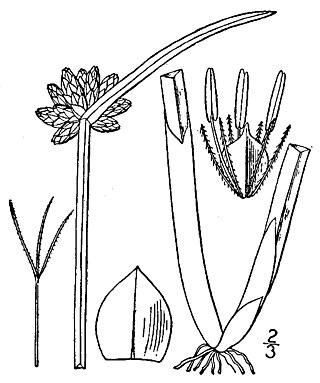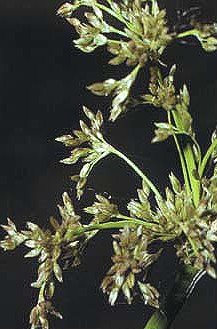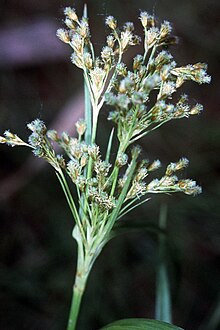
Scirpus is a genus of grass-like species in the sedge family Cyperaceae many with the common names club-rush, wood club-rush or bulrush. They mostly inhabit wetlands and damp locations.

Schoeneoplectus californicus is a species of sedge known by the common names California bulrush, southern bulrush and giant bulrush. It is also sometimes called "tule", but the closely related Schoenoplectus acutus is the species most often referred to by that name.

Scirpus cyperinus, commonly known as woolgrass, is an emergent wetland herb that is native to the eastern United States and eastern Canada. Other common names include cottongrass bulrush and brown woolly sedge.

Schoenoplectus americanus is a species of flowering plant in the sedge family known by the common names chairmaker's bulrush and Olney's three-square bulrush. It is native to the Americas, where it is known from Alaska to Nova Scotia and all the way into southern South America; it is most common along the East and Gulf Coasts of the United States and in parts of the western states. It grows in many types of coastal and inland wetland habitat, as well as sagebrush, desert scrub, chaparral, and plains. This rhizomatous perennial herb easily exceeds two meters in height. The stiff stems are sharply three-angled and usually very concave between the edges. Each plant has three or fewer leaves which are short and narrow. The inflorescence is a small head of several spikelets which may be brown to bright orange, red, purplish, or pale and translucent. They have hairy edges. The fruit is a brown achene. The plant reproduces sexually by seed and colonies spread via vegetative reproduction, sprouting from the rhizomes.

Scirpus congdonii is a species of flowering plant in the sedge family known by the common name Congdon's bulrush after noted Californian botanist J.W. Congdon. It is native to the mountains and plateaus of far northern California and adjacent sections of southern Oregon and western Nevada. It can be found in wetland habitat and other moist areas, such as mountain meadows and waterways. It is a perennial herb forming a loose or dense clump of erect stems growing up to half a meter tall, solitary stems sometimes occurring as well. The stems are three-angled and narrow at the middle. Sheathing leaves occur at the stem bases as well as higher up the stems. The inflorescence occurs at the end of the stem, with small additional ones growing from leaf axils. The inflorescence consists of several clusters of many spikelets wrapped at the bases in a leaflike bract.
Scirpus diffusus is a species of flowering plant in the sedge family known by the common name umbrella bulrush. It is endemic to California, where it can be found in several of the high mountain ranges from the Klamath Mountains to the Sierra Nevada. It grows in wetland habitat and other moist areas, such as mountain meadows. It is similar to Scirpus congdonii and was described from herbarium specimens once mislabeled as such. It is a perennial herb forming a clump of erect stems growing up to a meter tall, solitary stems sometimes occurring as well. The stems are three-angled and narrow at the middle. Sheathing leaves occur at the stem bases as well as higher up the stems. The inflorescence occurs at the end of the stem, with small additional ones growing from the uppermost leaf axial. The inflorescence consists of several clusters of many spikelets wrapped at the bases in a leaflike bract.

Schoenoplectus heterochaetus is a species of flowering plant in the sedge family known by the common name slender bulrush. It is native to North America, where it can be found in scattered locations in Canada and the United States.
Isolepis carinata is a species of flowering plant in the sedge family known by the common name keeled bulrush. It is native to North America, where it is mostly distributed around the southeastern United States; it can also be found on the California coast. It grows in many types of moist and wet habitat, including disturbed, cultivated, and landscaped areas. It is an annual herb producing clumps of slender, erect stems up to 25 centimeters tall. The inflorescence is a solitary spikelet just a few millimeters long, or a cluster of up to three spikelets. These are accompanied by a stiff bract which looks like an extension of the stem growing past the spikelets.

Scirpus microcarpus is a species of flowering plant in the sedge family known by the common names panicled bulrush, smallfruit bulrush, and barberpole bulrush. It is native to North America, where it can be found throughout the northern and western regions, from Alaska across Canada to the northeastern United States, in most of the central and western states, and in Baja California. It grows in many types of moist and wet habitat. It is a perennial herb growing from a long rhizome system. The erect, three-angled stems often exceed one meter tall. Sheathing leaves occur at the stem bases as well as higher up the stems. The inflorescence is a panicle of many clusters of spikelets and leaflike bracts on long, thin branches. The fruit is a pale, smooth achene less than 2 millimeters long.

Schoenoplectiella mucronata is a species of flowering plant in the sedge family known by the common names bog bulrush, rough-seed bulrush, and ricefield bulrush. It is native to Eurasia, Africa and Australia. It grows in moist and wet terrestrial habitat, and in shallow water. It is a perennial herb growing from a short, hard rhizome. The erect, three-angled stems grow in dense clumps and can reach a metre tall. The leaves take the form of sheaths wrapped around the base of stem, but they generally do not have blades. The inflorescence is a headlike cluster of cone-shaped spikelets accompanied by an angled, stiff bract which may look like a continuation of the stem.

Amphiscirpus is a monotypic genus of flowering plants in the sedge family containing the single species Amphiscirpus nevadensis, which is known by the common name Nevada bulrush.

Bolboschoenus robustus is a species of flowering plant in the sedge family. It is known by many common names: saltmarsh bulrush, alkali bulrush, sturdy bulrush, seacoast bulrush, stout bulrush, three-cornered sedge or leafy three-cornered sedge, and seaside club-rush.
Schoenoplectiella saximontana is a species of flowering plant in the sedge family known by the common name Rocky Mountain bulrush. It is native to North America, where it is known from several areas scattered throughout Canada, the United States, and Mexico. It grows in moist and wet habitat or shallow water, including disturbed places. It is an annual herb producing tufts of very thin, erect stems which reach about 30 centimeters in maximum height. The leaves sheath the stems and have short, narrow blades. The inflorescence is a cluster of several spikelets accompanied by a long, stiff, stemlike bract.

Isolepis setacea is a species of flowering plant in the sedge family known by the common names bristle club-rush and bristleleaf bulrush. It is native to Eurasia and Africa, and possibly Australasia. It can be found in other places, including some areas in North America, where it is an introduced species. It grows in many types of moist and wet habitat, often in coastal regions, and sometimes inland. It is a perennial herb which forms mats of very thin, grooved, erect or arching stems up to about 20 centimeters tall. The leaves sheath the stem bases and have short, flat, thick blades. The inflorescence is a solitary spikelet just a few millimeters long, or a cluster of up to three spikelets. These are accompanied by a stiff bract extending past the flowers.

Schoenoplectus tabernaemontani is a species of flowering plant in the sedge family known by the common names softstem bulrush, grey club-rush, and great bulrush. It can be found throughout much of the world; it has been reported from every state in the United States, and from every province and territory in Canada except Nunavut. It grows in moist and wet habitat, and sometimes in shallow water.

Scirpus ancistrochaetus is a rare species of flowering plant in the sedge family known by the common names barbedbristle bulrush and northeastern bulrush. It is native to the northeastern United States from New Hampshire south to Virginia. It used to be found in Quebec but it is now thought to be extirpated there. It was also believed extirpated from the state of New York, but at least one population has been rediscovered in Steuben County in 2010. It is threatened by the loss and degradation of its wetland habitat. It is a federally listed endangered species.

Juncus roemerianus is a species of flowering plant in the rush family known by the common names black rush, needlerush, and black needlerush. It is native to North America, where its main distribution lies along the coastline of the southeastern United States, including the Gulf Coast. It occurs from New Jersey to Texas, with outlying populations in Connecticut, New York, Mexico, and certain Caribbean islands.

Schoenoplectiella hallii is a species of flowering plant in the sedge family known by the common name Hall's bulrush. It is native to the United States, where it has a disjunct distribution, occurring in widely spaced locations throughout the Midwest and East. It is a rare plant.
Scirpus longii is a species of flowering plant in the sedge family known by the common name Long's bulrush. It is native to eastern North America, where it is limited to the Atlantic coastal plain.















